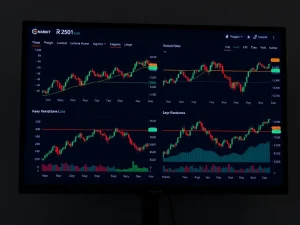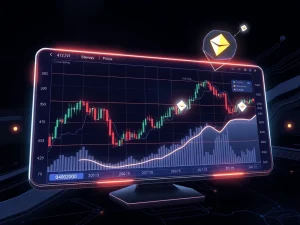Crypto Leaders: Meet the 5 Dominant Figures Shaping the Future of Digital Assets

The landscape of digital finance is rapidly evolving. Today, a new class of crypto leaders dictates the industry’s direction. These influential figures are reshaping how we interact with money and technology. Power has decisively shifted from traditional gatekeepers to a select group of innovators. They are driving onchain finance and control. Consequently, understanding their strategies is crucial for anyone in the crypto space.
The New Center of Gravity: Who Holds Crypto Power?
For a long time, the crypto world revolved around exchanges and regulators. However, this dynamic has changed significantly since 2024. Today, power concentrates around five critical levers. These include dollar liquidity, capital markets, base-layer roadmaps, blockspace security, and high-throughput execution. Therefore, new forces are now steering the industry’s future.
- Stablecoins provide essential dollar liquidity.
- ETFs and tokenization connect crypto to capital markets.
- Base-layer upgrades define core technological advancements.
- Blockspace security ensures network integrity.
- High-throughput execution enables fast, efficient transactions.
Mainstream capital now flows through Bitcoin (BTC) exchange-traded funds (ETFs). For instance, BlackRock’s IBIT alone manages approximately $85 billion in assets. Moreover, stablecoins have become the fastest dollar settlement rail. The GENIUS Act also provides a federal framework for their operation in the U.S. On the technology front, Ethereum’s Pectra upgrade and Solana’s Firedancer client are making significant strides. EigenLayer has also transformed staked Ether (ETH) into a rentable security market. Expect visible moves on all these fronts in the coming months.
Defining Influence: How We Identified Our Top Five
We defined “power” by specific criteria. First, direct control over capital flows or block space was essential. Second, the ability to set and ship roadmaps that others must follow showed influence. Finally, credible and announced next steps landing in the next few quarters indicated future impact. These standards helped us identify the most impactful figures in crypto today.
1. Larry Fink (BlackRock): The Institutional Gateway via BlackRock ETF
Larry Fink, CEO of BlackRock, stands as a pivotal figure. BlackRock now controls the largest spot Bitcoin ETF. It also manages the most prominent institutional tokenized cash fund. The BlackRock ETF, IBIT, leads the market by assets. Furthermore, BUIDL has made tokenized Treasuries a mainstream product for qualified investors. This product is no longer tied to a single blockchain. BlackRock has also expressed interest in expanding its crypto ETF lineup beyond BTC and ETH. Therefore, Fink’s decisions significantly direct institutional capital.
BlackRock’s Power in Practice
- IBIT: Holds around $85.4 billion in net assets (August 20, 2025). This fund acts as the de facto TradFi on-ramp. It sets flows and fees across the segment.
- BUIDL: Manages over $1 billion in AUM (March 2025). It is no longer Ether-only. BlackRock and Securitize have launched new share classes, including on Solana (SOL). This expands distribution and composability.
Larry Fink plans more crypto ETFs. BlackRock is considering additional listings. These depend on demand and regulatory approval. Moreover, deeper tokenization plumbing is expected. BUIDL and its successors will integrate further with BlackRock’s Aladdin system. This is its portfolio and operations backbone. They will also push multichain access where counterparties need it. A single player at the center of ETF flows and tokenized cash can direct liquidity. They also determine who captures revenue both on- and off-chain. Did you know? IBIT was the fastest ETF in history to reach $10 billion. It hit this mark in just 34 trading days after launch.
2. Paolo Ardoino (Tether): Powering Liquidity with Tether Stablecoin
Paolo Ardoino leads Tether, issuer of USDt (USDT). This digital dollar underpins most of the crypto economy. It powers centralized exchanges, onchain markets, and cross-border payments. Tether’s immense scale gives Ardoino direct influence over dollar liquidity. He is also redeploying profits into hard infrastructure. These investments include Bitcoin mining, energy, and privacy-focused AI. This positions Tether as a critical operator in the stack. The Tether stablecoin is therefore indispensable.
Tether’s Market Influence
- USDT Market Cap: Approximately $167 billion (August 21, 2025). It is the largest in crypto. It also serves as the benchmark for onchain dollar liquidity.
- Energy and Mining Build-out: New Bitcoin mining data centers are underway. This includes a Brazil biogas project.
- U.S. Strategy Push: Tether hired Bo Hines. He was formerly associated with the White House’s crypto advisory group. His role is to shape Tether’s U.S. posture.
Paolo Ardoino plans to expand Tether’s hard-asset footprint. This includes energy and mining. He also aims to build an AI/edge-compute stack. This stack will provide privacy-preserving services. Additionally, he seeks to deepen payments and remittance flows. There is a focus on emerging-market USD corridors. Stablecoins already dominate these areas. When one issuer controls most of the crypto-dollar supply, its choices move the market. Reserve choices, compliance stance, and infrastructure spending can shift spreads. They also impact settlement times and chain adoption. With new U.S. stablecoin rules, scrutiny will rise. Yet, demand for dollar stablecoins continues to grow. Did you know? In 2024, Tether was the seventh-largest net buyer of U.S. Treasurys, surpassing several countries.
3. Vitalik Buterin (Ethereum): Driving Innovation with Ethereum Upgrade
Vitalik Buterin, co-founder of Ethereum, continues to shape the blockchain’s evolution. Ethereum’s May 2025 Pectra upgrade (now live) shipped EIP-7702. This allows externally owned accounts (EOAs) to act like smart-contract accounts. This account-abstraction step improves wallets, Layer 2s (L2s), and payments. Pectra also raised validator limits. This altered staking economics and node operations. Buterin’s influence, through writing, research, and core-dev work, determines what gets “enshrined” next. The latest Ethereum upgrade marks a significant step.
Ethereum’s Core Developments
- Pectra Live: EIP-7702 allows EOAs to temporarily execute code. This includes session keys, social recovery, and batched actions. It remains compatible with ERC-4337. This unlocks a smoother wallet user experience.
- Validator/Staking Updates: The maximum effective balance per validator increased from 32 ETH to 2,048 ETH. This consolidates stake and lowers consensus overhead.
Vitalik Buterin is planning further advancements. History expiry (EIP-4444) partially rolled out in July 2025. This shrinks disk requirements. It also paves the way for lighter nodes. Further iterations are expected. Verkle trees and statelessness are also under research. This aims to shift Ethereum to a Verkle-based state. It enables stateless clients and reduces hardware barriers. Enshrined PBS (ePBS) is another active area. This work aims to embed proposer-builder separation. It hardens censorship resistance and streamlines maximal extractable value (MEV) flows. Ethereum still sets norms for L2s, wallets, and onchain finance. Buterin’s roadmap directly influences costs, performance, and the developer experience across the ecosystem. Did you know? Buterin’s Balvi fund has donated millions to pandemic prevention research.
4. Anatoly Yakovenko (Solana): Scaling with the Solana Blockchain
Anatoly Yakovenko, co-founder of Solana, champions high-throughput and low fees. This combination has made Solana a hub for consumer-facing applications. It is also a platform for fast USD settlement. Stablecoin activity surged on the network in 2025. Yakovenko’s most ambitious project is Firedancer. This is an independent validator client built by Jump. It aims to boost resilience and capacity. Success would end Solana’s reliance on a single dominant client. It would also ensure true client diversity. The Solana blockchain continues to push boundaries.
Solana’s Performance and Diversity
- Firedancer Progress: Testing accelerated in 2025. Early “Frankendancer” hybrids shipped. The full client has replayed mainnet blocks. It also achieved seven-figure transactions per second (TPS) in controlled tests. This is a major milestone towards production.
- Stablecoin Scale: By H1 2025, Solana’s daily active stablecoin addresses consistently topped the multimillion mark. Float also rose rapidly.
Anatoly Yakovenko is planning a phased Firedancer rollout. Validators will watch diversity metrics. Jump will move from test performance to production hardening through late 2025. Payments and decentralized physical infrastructure networks (DePINs) are also a focus. Expect continued emphasis on payments UX. Real-world networks, like Helium’s business-onboarding model, are also key. Solana directly competes with Ethereum L2s on speed and cost. If Firedancer delivers, Solana’s execution economics will shift dramatically. This includes reduced tail risk from client bugs. It also means higher capacity for throughput-heavy apps. A sturdier base for global USD flows will emerge. This combination gives Yakovenko significant influence. He helps determine where the next wave of consumer payments settles. Did you know? Yakovenko conceived the proof-of-history idea during a late-night coffee binge, leading to the 2018 white paper.
5. Sreeram Kannan (EigenLayer): Redefining Security with Restaking
Sreeram Kannan, founder of EigenLayer, has transformed Ethereum’s stake. He created a marketplace for security. Actively validated services (AVSs) can now “rent” Ethereum’s trust. This eliminates the need for them to build their own validator sets. Slashing is live. A new multichain verification feature also exists. It allows AVSs to run on L2s while anchoring to Ethereum’s security. Kannan effectively coordinates an emerging layer. Many projects already depend on it. EigenLayer’s restaking model is innovative.
EigenLayer’s Impact on Security
- Slashing Shipped (April 17, 2025): Misbehavior can now be penalized. This completed EigenLayer’s original design. Billions in restaked assets and dozens of AVSs were participating at launch.
- AVSs on L2s: Multichain verification lets services execute on L2s. They still verify against Ethereum. This provides scalability without sacrificing trust.
Sreeram Kannan is planning to institutionalize risk. Expect movement towards standardized AVS risk models. Insurance and coverage tools are also anticipated. Operational frameworks that meet institutional requirements are essential. Analysts note these are crucial for wider adoption. Broader verification footprint is another goal. This includes continued expansion of L2-native verification and cross-domain services. Developer tooling, such as EigenCloud, will make “verifiability-as-a-service” more accessible. If more crypto infrastructure rents security through EigenLayer, Kannan’s roadmap becomes vital. It will influence who gets secured. It also impacts how risk is priced. Furthermore, it determines where developers choose to deploy. The ripple effects extend to L2 design, MEV markets, and institutional participation. Did you know? A16z purchased around $70 million of EigenLayer (EIGEN) tokens to back the EigenCloud launch, signaling strong VC confidence.
Beyond the Old Guard: Why Others Play a Lesser Role
Regulators and exchange leaders still hold importance. However, 2025’s decisive levers lie elsewhere. Richard Teng (Binance) channels large liquidity flows and listings. Jeremy Allaire (Circle) secured a fully regulated Markets in Crypto-Assets (MiCA) track for USDC in the EU. Yet, their reach appears narrower this cycle. Tether’s dominance of crypto-dollar supply, BlackRock’s ETF and tokenization pipelines, base-layer roadmaps (Ethereum and Solana), and EigenLayer’s new security market wield greater influence. For a broader anchor, consider derivatives. Perpetual futures accounted for approximately 68% of BTC trading volume year-to-date 2025. This shows that the real tone-setters control flows through ETFs, stablecoins, execution layers, and now restaking.
What’s Next for Digital Assets? Key Trends to Watch
The crypto landscape will continue its rapid evolution. Several key trends deserve close attention. These developments will shape the market’s trajectory.
- Tokenization Pace: BUIDL now exceeds $1 billion in AUM. It features a Solana share class. It is also accepted as collateral across multiple venues. This signals where onchain cash will settle.
- Stablecoin Infrastructure: The U.S. GENIUS Act is live. Treasury rulemaking and bankruptcy-priority rules could reshape issuer banking access and risk.
- Ethereum Post-Pectra: EIP-7702 is live. Partial history expiry is rolling out. The next flashpoint is enshrined PBS.
- Solana Execution: Firedancer’s rollout and payments integrations will show Solana’s headroom. This includes throughput and resilience gains.
- Restaking Maturation: Slashing and multichain verification are complete. The next milestones are standardized AVS risk models. Procurement frameworks for institutional adoption are also crucial.
This article does not contain investment advice or recommendations. Every investment and trading move involves risk, and readers should conduct their own research when making a decision.









